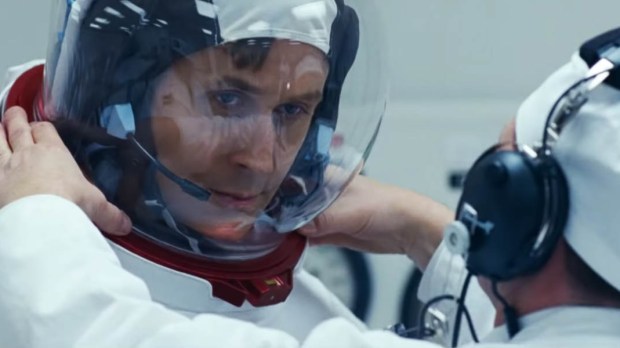Lenten Campaign 2025
This content is free of charge, as are all our articles.
Support us with a donation that is tax-deductible and enable us to continue to reach millions of readers.
Is there any quote more ingrained in the public consciousness than the words Neil Armstrong spoke as he stepped onto the moon? You could ask anyone at random what Armstrong said and chances are they’ll be able to recite, “That’s one small step for a man, one giant leap for mankind.” And yet, despite our certainty surrounding the event, director Damien Chazelle’s new film First Man is so intensely well-crafted that there are moments we legitimately doubt Armstrong will ever reach the lunar surface to utter those famous lines.
The movie begins with Neil (Ryan Gosling) still a test pilot exploring the limits of flight along Earth’s upper atmosphere. He is distracted in his work, however, as he and his wife Janet (Claire Foy) are in the midst of a losing battle against their youngest child’s malignant brain tumor. Following the girl’s untimely death, Armstrong makes the fateful decision to move across the country and join NASA’s space program. It’s the first of many times he will attempt to put distance between himself and his pain.
Much of the story that follows Armstrong’s selection as one of the “new nine” astronauts is a familiar one, especially to anyone who might have watched The Right Stuff more than a few times. We get to see the difficulties of the training regiment, the disappointing setbacks in the race to beat the Soviet Union into space, and the pressures of the public and political attentions placed upon the chosen few.
What makes this telling of the tale different is its singular focus on Armstrong and his wife. The film begins with a close-up on Neil in his cockpit and from there the camera rarely wanders more than a few feet away from him or Janet. It makes for a surprisingly intimate journey through what is otherwise grandiose subject matter.
Of course, this intimacy is also what lends the scenes of space travel their intensity. Thanks to the masterful editing and sound design (look for both to be up for awards), it feels as if we are practically there cheek-to-cheek with Armstrong within the claustrophobic confines of his space capsule. As it hurtles in and out of darkness, we hear each creak and moan of the straining spacecraft, every clarion call of the warning signals. Sometimes the images shake or spin so violently we can barely discern what is going on, Armstrong’s vertigo becoming our own. Given the overwhelming odds against them, it is a testament to human technology and willpower that these men were able to do what they did, and even though we know outcome beforehand, we are as relieved as they are when the landing module finally touches down on Luna.
And yet, despite all of the technical wizardry and teeth-clenching anxiety, the story remains a personal one. Much is made during the movie of Neil’s attempts to move himself further and further away from his daughter’s death, and what place could be further away than on the moon? Accordingly, the film bypasses most of the mission’s money shots (yes, it skips the placing of the American flag) and focuses instead on Armstrong’s contemplations regarding the reasons that have brought him so far from home.
“There is a sort of invisible blanket between the world and me,” C.S. Lewis wrote in A Grief Observed following the death of his wife, “I find it hard to take in what anyone says. Or perhaps, hard to want to take it in.” For Armstrong, his mission becomes his own invisible blanket which no one, not even his own wife or remaining children, seem able to remove. But as Lewis goes on to note, “Grief is like a long valley, a winding valley where any bend may reveal a totally new landscape.” For Armstrong, that notion becomes a literal reality as his grief ultimately drives him to set foot on a landscape no man has before him. To drive home the point, the film cleverly switches film stock so that the surface of the moon looks entirely alien to what we’ve seen before.
Armstrong himself was not an overly religious man, describing himself to be merely “deist” in his beliefs, but it’s not hard to find the touch of God in his story, at least as it’s presented in First Man. The Christian religion, one that includes the story of the Cross, is not one that sweeps the suffering of grief under the rug. Rather it confronts it directly, accepts its reality, and travels with it to wherever it may take us. Obviously, that may not be to the moon like it was with Neil Armstrong, but our own journeys through grief, like his, can still end on a note of hope if we just keep to the mission.

